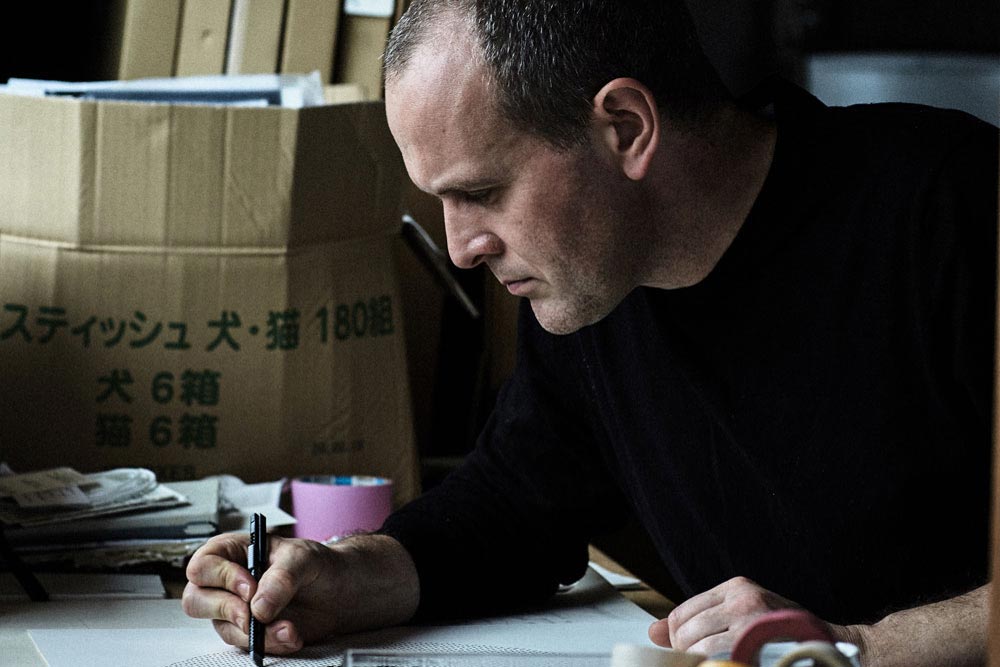Hong Kong
PAINTING
MIXED MEDIA
What if the solution to a puzzle you’d been struggling to solve ended up being the METHOD you were using to solve it? Sounds strange, but that’s exactly how English artist and researcher Michael Whittle came up with the idea for his award-winning 2015 PhD thesis, which has since been downloaded more than 58,000 times in 25 different countries. After receiving his MA from London's Royal College of Art in 2009, he moved to Japan on scholarship to Kyoto City University of Arts. Having difficulty coming up with a good research question to pursue for his fine art PhD, he began covering the walls of his studio with images of his favorite artworks, quotes, texts, covers, etc. — adding, moving, removing and rearranging for weeks. Until one day he stepped back and realized he’d constructed a giant diagram of all things relating to . . . diagrams.
When a Google query, ‘What's the study of diagrams called?’ came up with almost nothing, he kept digging until he landed on a new field of study called diagrammatology. Recognizing that it provided the perfect overlap of his interests in art and science, he got to work and titled his thesis: ’Romantic Objectivism: Diagrammatic thought in contemporary art.’ Whittle helped map the deep philosophical, semiotic and aesthetic links between art and science. His research reveals diagrams to be powerful tools with ancient origins and modern applications, exploring how they have helped shape human thought from the Stone Age to the present day — where they have become the visual language of science itself.

ARTIST'S NOTE
“With art’s incorporation of diagramming as part of its tools and techniques of conception and production, we can see not only the transformation of artistic practice via diagramming, but also a transformation of our notion of what the diagram is itself.”
Inspired by great artists known to have incorporated diagrams into their creative practices and work— from the notebooks of Leonardo da Vinci to Arakawa and Gins’ ‘Mechanism of Meaning’ series and the wall drawings of Sol Lewitt — Whittle’s own studio practice draws on images, ideas and data found in scientific research papers. In his 2018 exhibition Portraits of Thought, the artist debuted a new series of his own detailed diagrammatic drawings and paintings illustrating the intricate interplay between contemporary art and science.
And though the Kyoto-based artist has made a career interweaving the two, it didn’t start out that way. An undergrad studying biochemistry in the UK, in 1997 he moved to Hamburg for a year-long assignment working at a research laboratory. The city had just opened the doors to its new Kunsthalle, one of the largest art museums in Germany, and Whittle quickly became a regular. “I visited the collection obsessively and taught myself about the work of artists like Caspar David Friedrich, Paul Klee, Joseph Beuys and Hanne Darboven,” says Whittle. “When I returned to the UK, I completed my degree in Biochemistry then immediately signed up for art school.”
![]()

What kind of art did you grow up with?
“My father went to art college, and I grew up surrounded by prints and reproductions of famous works by Escher, da Vinci, Rembrandt and the Pre-Raphaelites. It felt like growing up in an art library and gallery in one.”
When did combining art and science start to seem like a viable path for your work?
“During my BA graduation show, I sold a small drawing to a professor of medicine from Dundee University in Scotland. I think he was one of the few people who had recognised all of the biological signs and symbols I'd included in that particular image, and it suddenly made me realise that a combination of art and science could tap into a whole new audience outside of the world of contemporary art.”
What’s something you collect that we might not see in other collections?
“For many years I've collected pages from damaged encyclopedias, mostly from antiquarian bookshops in London or online. They're usually only a few dollars each, despite being original prints from the 18th and 19th centuries. Each page even has the slight indentation left from the metal plate from which it was created two or three hundred years ago.”
Any advice for new artists about group shows?
“Use group shows and small exhibitions as a way to make all of the mistakes you need to make now rather than later. You'll learn something new every time you hang a show. After graduating from the RCA in London, I worked at White Cube Gallery for a year, and learned all the practical and professional skills they didn't teach me at art college. It was a priceless experience and a fascinating look behind the scenes of the commercial art world.”





